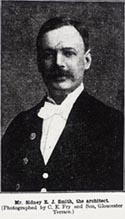|
A gallery for British art |
The site |
The architecture |
Extensions |
The restaurant |
Out of the shadows
 |
The architecture

Sidney R.J. Smith was the architect selected to design the gallery.
His initial design was rejected because it seemed 'pretentious' with its decorative winged eagles and cupolas.
So Smith produced an alternative proposal which was accepted, and this formed the design of the core building that we see today.
With its grand porticoed entranceway and central dome it resembled a temple or palace, providing the sense of authority and tradition appropriate for
a national gallery.
The statue of Britannia with a lion and a unicorn on top of the pediment emphasised its function as a gallery of British art.
 Sidney R.J. Smith
Sidney R.J. Smith
© Tate Archive 2003 |
|
